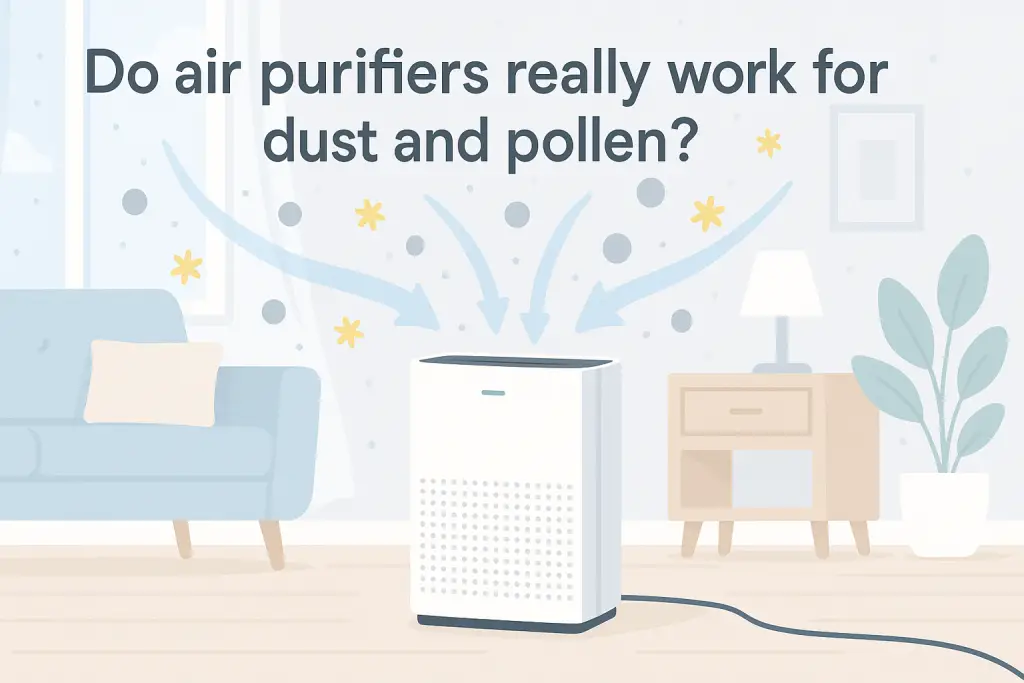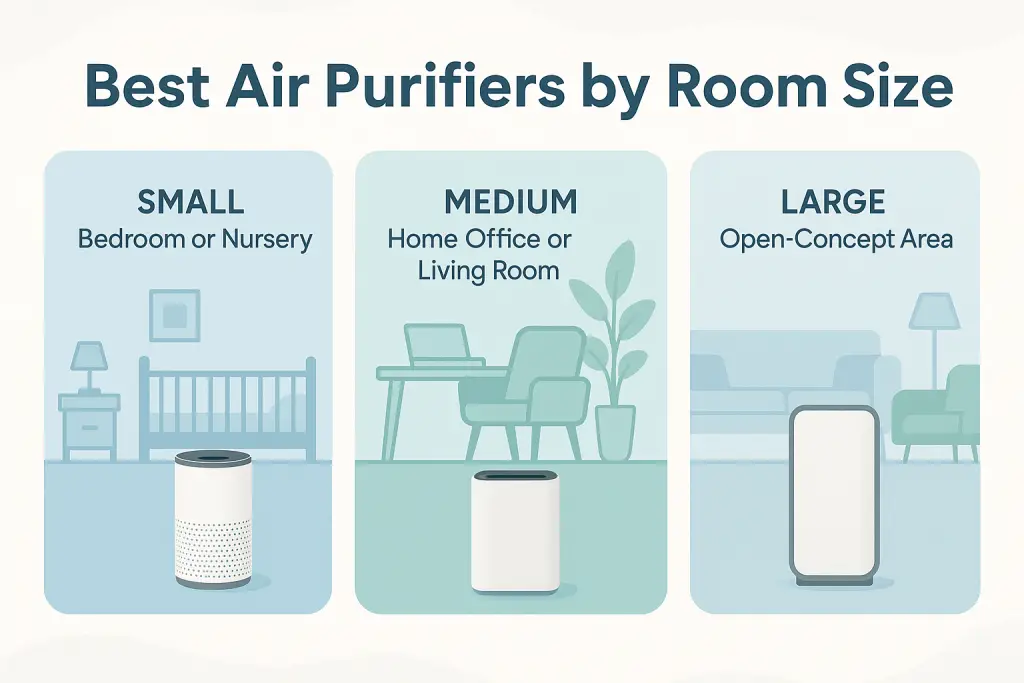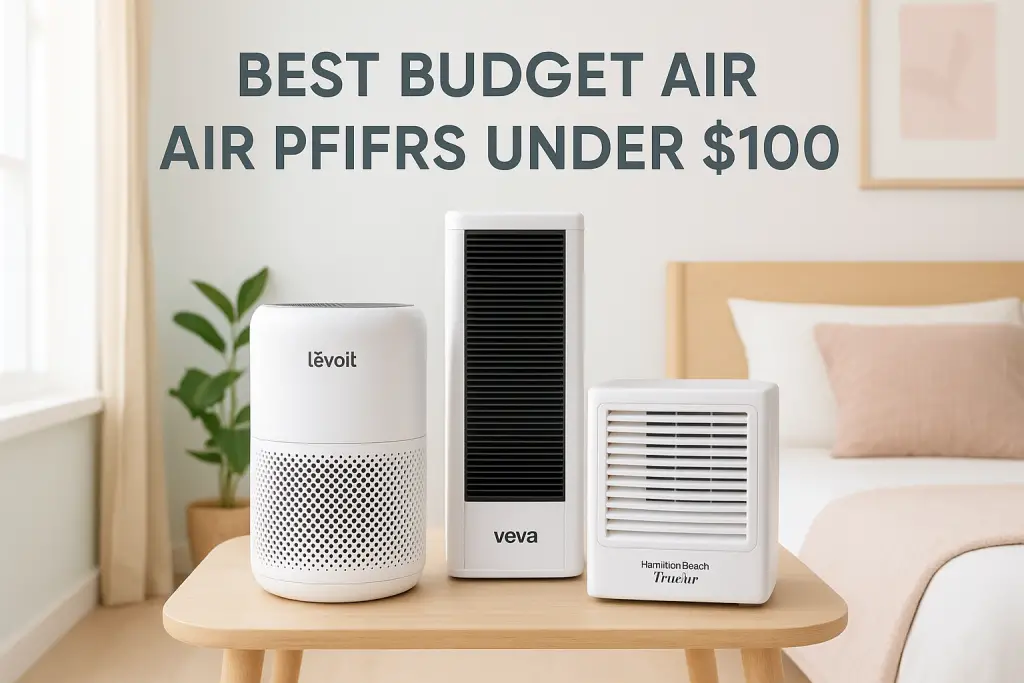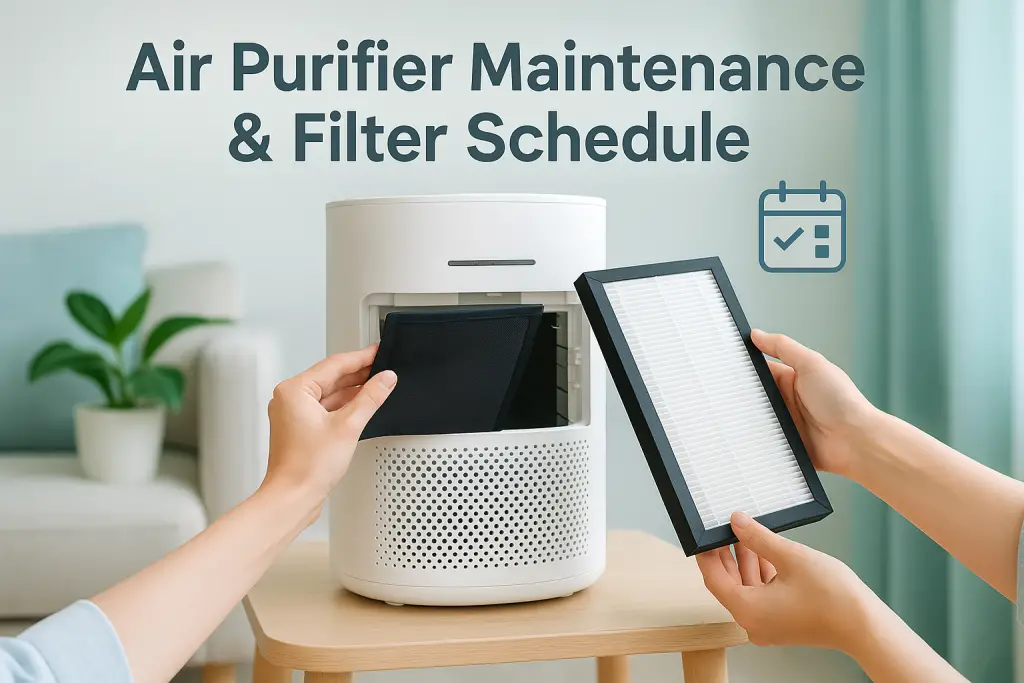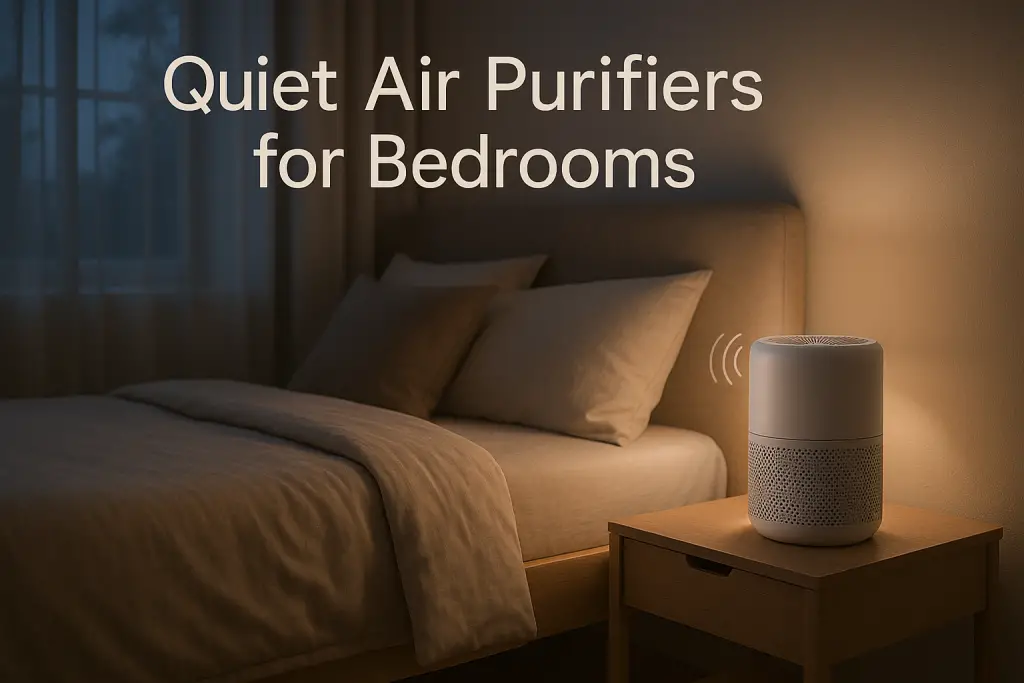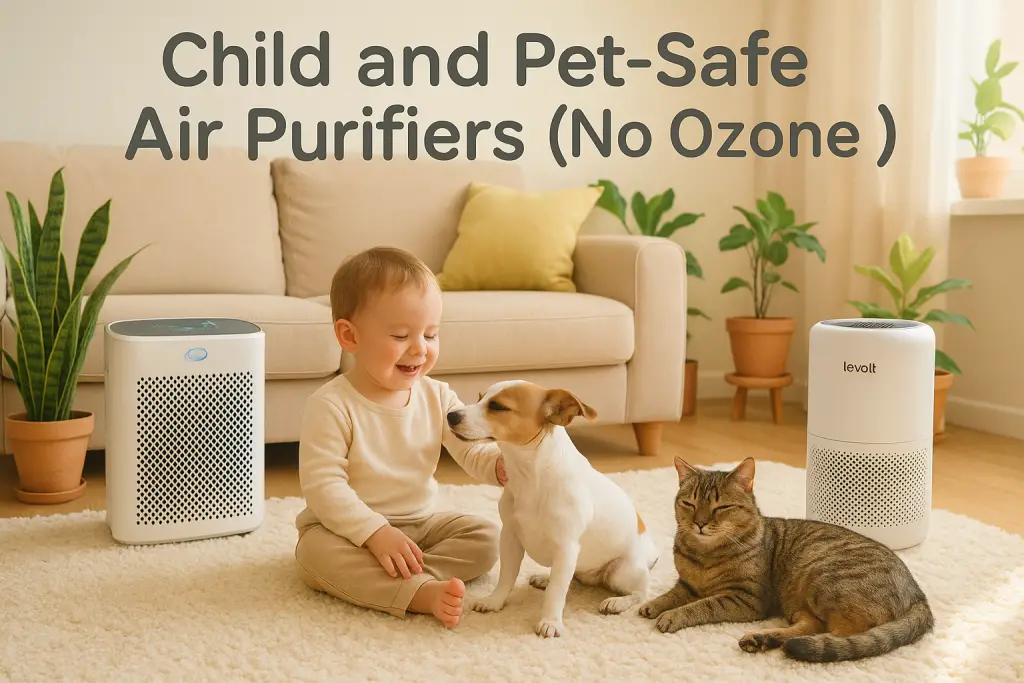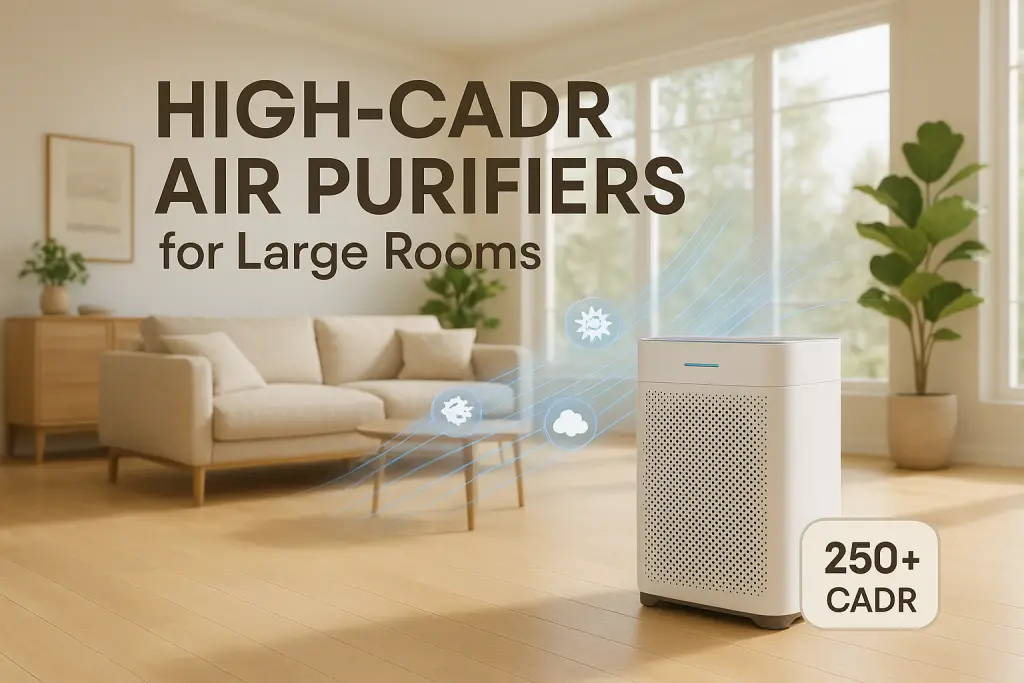Air purifiers have become a popular solution for those suffering from allergies, especially related to dust and pollen. But the big question remains: do these devices actually deliver on their promises? The short answer is yes – high-quality air purifiers with HEPA filtration are scientifically proven to capture and remove dust particles and pollen from indoor air. These devices can trap 99.97% of particles as small as 0.3 microns, which includes most common allergens. This comprehensive guide examines the science behind air purification, evaluates the evidence, and provides practical advice for choosing and using air purifiers effectively for dust and pollen removal.
Understanding Dust and Pollen: What You’re Actually Filtering
Before examining how air purifiers work, it’s crucial to understand exactly what dust and pollen are, their composition, and why they cause problems for many people.
Dust is not a single substance but a complex mixture of particles ranging from 0.5 to 100 microns in size. It consists of dead skin cells, pet dander, textile fibers, soil particles, and microscopic organisms like dust mites. During dust storms or high wind conditions, outdoor dust can infiltrate homes at alarming rates, significantly worsening indoor air quality.
Pollen, on the other hand, consists of tiny reproductive cells from plants, typically ranging from 10 to 100 microns. These particles are released by trees, grasses, and weeds as part of their reproductive process. For millions of allergy sufferers, these seemingly harmless particles trigger immune system responses resulting in sneezing, congestion, and other uncomfortable symptoms.
Both dust and pollen can cause significant health issues, especially for those with allergies, asthma, or other respiratory conditions. Understanding the particle size of these allergens helps explain why certain air purification technologies work better than others.
Dust Composition and Sources in the Home
Household dust is a complex mixture of particles from both indoor and outdoor sources, with composition varying significantly between homes.
The typical household dust composition includes:
- Human skin cells (20-50%)
- Textile and carpet fibers (10-20%)
- Pet dander and hair (if pets present, 5-30%)
- Dust mite bodies and waste (5-10%)
- Outdoor soil particles (3-15%)
- Food particles (1-5%)
- Insect fragments (1-5%)
- Plant material (1-5%)
- Microscopic fungi and bacteria (1-10%)
Common dust-generating activities include walking on carpets, making beds, folding laundry, and vacuuming without HEPA filtration. While dust settles on surfaces, physical movement and air currents continuously resuspend particles into the breathing zone. Even with regular cleaning, some dust will still settle on furniture, though air purifiers can significantly reduce the amount that remains airborne.
Pollen Types and Seasonal Patterns
Pollen varies significantly by plant type, season, and geographic region, affecting which allergens you’re exposed to throughout the year.
Major pollen categories include:
- Tree pollen: Predominant in early spring (February-May), particle size 20-60 microns
- Grass pollen: Most common in late spring and summer (May-July), particle size 20-25 microns
- Weed pollen: Peaks in late summer and fall (August-October), particle size 15-90 microns
Pollen enters homes through open windows, doors, on clothing, pets, and through ventilation systems. Though outdoor pollen counts can be extremely high during peak seasons, indoor concentrations are typically 10-50% of outdoor levels, depending on how well the home is sealed.
Weather conditions significantly impact pollen distribution. Warm, dry, windy days create ideal conditions for pollen dispersal, while rain temporarily reduces airborne pollen by washing it out of the air.
How Air Purifiers Capture Dust and Pollen: The Science Explained
Air purifiers use several distinct technologies to capture airborne particles, with varying effectiveness for dust and pollen specifically.
The basic operating principle is simple: air purifiers pull room air through a series of filters using a fan, trap contaminants in these filters, and release cleaner air back into the room. This creates a continuous cycle that gradually reduces airborne particle concentrations.
Most effective air purifiers use mechanical filtration, which physically traps particles as air passes through filter material. HEPA (High-Efficiency Particulate Air) filters are the gold standard, consisting of densely packed fibers arranged in a fine mesh that captures particles through several mechanisms:
- Interception: Particles follow airflow streamlines and stick to fibers when passing close enough
- Impaction: Larger particles collide directly with fibers due to inertia
- Diffusion: Smallest particles move randomly due to Brownian motion and eventually contact fibers
It’s important to understand that air purifiers have limitations. They can’t remove particles that have already settled on surfaces, and they work best in enclosed spaces. The effectiveness is also determined by the air exchange rate (how quickly the device can filter all air in a room) and the specific filtering technology employed.
HEPA Filtration: The Gold Standard for Particle Removal
High-Efficiency Particulate Air (HEPA) filtration is widely considered the most effective technology for removing airborne dust and pollen.
True HEPA filters must meet strict efficiency standards, capturing at least 99.97% of particles 0.3 microns in diameter. This size is considered the most penetrating particle size (MPPS) – particles that are larger or smaller are actually captured with even greater efficiency.
For perspective on HEPA effectiveness with common allergens:
- Dust mite allergens (10-24 microns): >99.99% removal efficiency
- Pet dander (5-10 microns): >99.99% removal efficiency
- Pollen (10-100 microns): >99.99% removal efficiency
- Fine dust (2.5 microns): >99.97% removal efficiency
Not all HEPA-labeled products are equal. True HEPA filters (H13 or higher) offer superior performance compared to “HEPA-type” or “HEPA-like” filters, which don’t meet the same stringent standards. HEPA filters typically need replacement every 6-12 months, depending on air quality conditions and usage.
Other Filtration Technologies: Comparing Effectiveness
While HEPA filtration is most effective for dust and pollen, several other technologies are available, each with specific strengths and limitations.
| Technology | Dust Removal Effectiveness | Pollen Removal Effectiveness | Key Considerations |
|---|---|---|---|
| Activated Carbon | Poor (not designed for particles) | Poor (not designed for particles) | Excellent for odors and some gases; works well for VOCs and formaldehyde but not particles |
| Ionizers | Moderate | Moderate | Charges particles that stick to surfaces; may produce ozone |
| Electrostatic Precipitators | Good | Good | Uses electrical charges to collect particles; requires cleaning |
| UV Light | Poor (not designed for particles) | Poor (not designed for particles) | Targets microorganisms, not physical particles |
| Photocatalytic Oxidation | Poor (not designed for particles) | Poor (not designed for particles) | Better for gases and VOCs; ineffective for dust and pollen |
Many modern air purifiers combine multiple technologies, such as HEPA filters for particles plus activated carbon for odors and gases. For dust and pollen specifically, HEPA filtration should be the primary technology, with other features serving as complementary functions.
Consumers should be cautious about ionizers and ozone generators, as some may produce ozone, a lung irritant that can worsen respiratory conditions. California has even banned air purifiers that produce ozone above certain thresholds.
Scientific Evidence: Do Air Purifiers Really Work for Dust and Pollen?
Beyond manufacturer claims, what does independent research actually tell us about air purifier effectiveness for dust and pollen removal?
Multiple peer-reviewed studies confirm that HEPA air purifiers significantly reduce airborne dust and pollen concentrations in controlled environments. A comprehensive review published in the Journal of Asthma concluded that HEPA air purifiers reduced particulate matter by an average of 69-80% in residential settings.
Laboratory studies typically show higher efficiency rates than real-world testing due to controlled conditions. Under ideal laboratory conditions, HEPA purifiers remove over 99% of test particles. In actual homes, researchers typically observe 30-90% reduction in airborne particulates, depending on:
- Room size and configuration
- Air exchange rate of the purifier
- Ongoing sources of new particles
- Air leakage from other spaces
- Activity levels in the space
Particularly relevant for allergy sufferers, clinical studies have demonstrated that using HEPA air purifiers in bedrooms reduced allergy symptoms by 26-75% among participants with dust or pollen allergies. A 2018 double-blind study found significant improvement in nasal symptoms and sleep quality among pollen allergy sufferers using air purifiers versus those with placebo devices.
The American Academy of Allergy, Asthma and Immunology (AAAAI) and the American College of Allergy, Asthma and Immunology (ACAAI) both recommend HEPA air purifiers as part of allergen avoidance strategies for sensitive individuals.
Independent Laboratory Testing Results
Multiple independent laboratories have tested air purifiers specifically for dust and pollen removal capacity, providing objective performance data.
The Clean Air Delivery Rate (CADR) is the most widely recognized standard for measuring air purifier performance. Developed by the Association of Home Appliance Manufacturers (AHAM), CADR indicates how quickly a purifier can remove specific particles from a standardized test chamber. The rating is expressed in cubic feet per minute (CFM), with separate scores for tobacco smoke, dust, and pollen.
For example, a purifier with a dust CADR of 200 can reduce dust concentration at the same rate as adding 200 cubic feet per minute of perfectly clean air. Higher CADR numbers indicate faster cleaning, with top-performing units achieving dust and pollen CADR ratings of 300+.
Consumer Reports and other independent testing organizations regularly evaluate air purifiers, finding that units with true HEPA filtration consistently outperform non-HEPA models for dust and pollen removal. Models designed for heavy roadside dust or industrial environments often feature enhanced pre-filtration and higher air flow rates.
Room size significantly impacts real-world performance. A purifier with a dust CADR of 200 is typically suitable for rooms up to 310 square feet, using the formula: (CADR × 1.55 = recommended room size in square feet). Using an undersized purifier is one of the most common reasons for disappointing results.
Clinical Studies: Symptom Relief for Allergy Sufferers
Beyond particle removal metrics, several clinical studies have examined whether air purifiers actually reduce allergy symptoms in real patients.
A randomized controlled trial published in JAMA Internal Medicine found that HEPA air purifiers reduced particulate matter concentrations by 29-55% in participants’ homes and improved clinical symptoms of allergic rhinitis by approximately 25% compared to the control group. This improvement was particularly noticeable for pollen-sensitive individuals during peak seasons.
“Air purifiers with HEPA filtration represent one of the few evidence-based environmental control measures that consistently demonstrate clinical benefit for appropriate patients,” states Dr. David Lang, past president of the American Academy of Allergy, Asthma and Immunology.
Studies focusing specifically on dust mite allergies show that while air purifiers reduce airborne dust particles effectively, additional measures like allergen-proof bedding are necessary because dust mites primarily live in mattresses and upholstery. The clinical benefit appears greatest when air purifiers are part of a comprehensive allergy and asthma management protocol.
The strongest symptom improvements are typically reported for:
- Nasal congestion
- Sneezing frequency
- Eye irritation
- Sleep quality
- Reduction in rescue medication use
Choosing the Right Air Purifier for Dust and Pollen
Selecting an effective air purifier for dust and pollen requires understanding several key specifications that directly impact performance.
The most critical features for dust and pollen removal include:
- Filtration System: True HEPA filtration (H13 or higher) is essential for capturing both dust and pollen particles. Look for certification language stating “99.97% of particles at 0.3 microns” rather than vague terms like “HEPA-type.”
- CADR Rating: Choose a purifier with dust and pollen CADR ratings appropriate for your room size. For bedrooms and living spaces, aim for dust/pollen CADR ratings of at least 150-200.
- Room Coverage: Calculate your room’s square footage and select a purifier rated for at least that area. For allergies, many experts recommend selecting a purifier rated for 1.5x your actual room size.
- Air Changes Per Hour (ACH): For allergies, look for purifiers that provide at least 4-5 air changes per hour in your specific room size. Higher is better for severe allergies.
Additional considerations that affect long-term satisfaction include:
- Noise Levels: Most purifiers range from 20-60 decibels depending on speed settings. Quiet operation is particularly important for bedroom use, where noise can disturb sleep.
- Filter Replacement Costs: Annual maintenance can range from $30-$200 depending on model. Calculate this ongoing expense when comparing options.
- Energy Consumption: Most modern air purifiers use 15-100 watts depending on fan speed, similar to a light bulb. ENERGY STAR certified models typically use 40% less energy.
- Smart Features: Auto-modes with particle sensors can automatically adjust to changing air quality conditions, increasing effectiveness and energy efficiency.
Price ranges typically fall into three tiers: budget ($50-$150), mid-range ($150-$350), and premium ($350+). For effective dust and pollen removal in medium-sized rooms, expect to invest at least $150-$300 for a quality unit with true HEPA filtration.
Key Specifications That Actually Matter for Allergen Removal
When evaluating air purifiers specifically for dust and pollen removal, certain specifications directly impact performance more than others.
In order of importance:
- Filtration Technology: True HEPA filtration (99.97% at 0.3 microns) is non-negotiable for allergen control. H13 or H14 HEPA filters offer even higher efficiency. Without true HEPA filtration, even units with high airflow will fail to capture the smallest allergen particles.
- CADR for Dust and Pollen: These specific ratings measure how quickly the unit cleans these particular contaminants. Look for dust CADR ratings above 150 and pollen CADR above 175 for rooms up to 250 square feet.
- Room Size Rating vs. Actual Room: For allergy sufferers, select a unit rated for at least 20% more area than your actual room size. This ensures adequate air cleaning even under challenging conditions.
- Air Changes Per Hour: This calculation determines how many times the purifier can filter all air in the room each hour. Allergy sufferers should aim for 4-5 ACH minimum.
- Pre-filter Quality: A good washable pre-filter extends the life of the main HEPA filter by capturing larger dust and hair particles first.
Features that aren’t necessarily critical for allergen removal but may be beneficial include air quality sensors, filter replacement indicators, and programmable timers. Remote control and app connectivity are conveniences rather than performance enhancers.
Verify manufacturer claims by checking for third-party certifications like AHAM Verifide, CARB certification (California Air Resources Board), and ENERGY STAR ratings. These independent validations provide greater assurance of performance than manufacturer testing alone.
Special Considerations for Severe Allergy Sufferers
People with severe allergies or asthma have additional considerations when selecting an air purifier for maximum relief.
For those with significant sensitivities, consider:
- Multi-purifier Strategy: Place separate units in bedrooms and main living areas rather than relying on a single unit. This provides continuous filtration in the most used spaces.
- “Clean Room” Approach: Focus on creating one allergen-controlled space (typically the bedroom) with enhanced filtration, allergen-proof bedding, and strict cleaning protocols.
- Medical-Grade Filtration: Consider H13 or H14 HEPA filters, which exceed standard HEPA requirements and capture 99.95-99.995% of particles at 0.3 microns.
- HVAC Integration: For whole-home improvement, combine portable air purifiers with high-MERV HVAC filters (MERV 11-13) and regular professional duct cleaning.
“For patients with severe allergies, I typically recommend creating an allergen-controlled sleeping environment first, as we spend about a third of our lives in the bedroom,” advises Dr. Jennifer Collins, board-certified allergist and immunologist. “A high-quality HEPA air purifier running continuously in the bedroom often provides the most immediate symptom relief.”
For those with specific seasonal pollen allergies, consider purchasing a second dedicated unit for peak season use or a unit with higher capacity that can be moved as needed.
Maximizing Air Purifier Effectiveness: Placement, Operation and Maintenance
Even the best air purifier will underperform if improperly placed, operated, or maintained. Follow these evidence-based guidelines to maximize effectiveness.
Optimal placement significantly impacts performance:
- Position the purifier at least 3-4 feet away from walls and furniture to allow proper air circulation
- Place units in the center of the room when possible, or in areas where you spend the most time
- Keep doors and windows closed in rooms with operating air purifiers
- Avoid placing near curtains, bookshelves, or other obstacles that can block airflow
- For bedrooms, position the purifier 6-10 feet from the bed, preferably with airflow directed toward the sleeping area
Operating guidelines for maximum effectiveness:
- Run the purifier continuously at medium speed for general use rather than intermittently at high speed
- During high pollen days or after dusting/vacuuming, use the highest setting for 1-2 hours
- For sleep, use night mode or lower fan speeds if noise is a concern
- If your purifier has an auto mode, ensure sensors are clean and properly calibrated
- For severe allergies, maintain operation even when away from home
Common placement mistakes that reduce effectiveness include positioning the purifier in corners, behind furniture, near strong air currents from fans or vents, or too close to walls.
Seasonal adjustments should include increased fan speeds during peak pollen seasons and more frequent filter checks during high dust periods.
Room-by-Room Placement Optimization
Air purifier placement significantly impacts performance, with optimal positions varying by room type and layout.
For bedrooms:
- Position the purifier 6-10 feet from the bed, with airflow directed toward the sleeping area
- Avoid placement directly beside the bed where noise may disturb sleep
- For small bedrooms, elevate the purifier on a solid, stable surface at least 2 feet off the floor
- Keep at least 3 feet from humidifiers or vaporizers to prevent moisture damage
For living rooms:
- Central placement provides the most even coverage
- In open-concept spaces, position the unit in the most used area
- For L-shaped or divided rooms, consider a more powerful unit or multiple smaller units
- Keep away from TVs and speakers that may create static interference
Door and window considerations:
- Position units 6-8 feet from frequently used exterior doors
- During pollen season, place units between windows and main living spaces
- For rooms with multiple entries, position the purifier to intercept airflow from the busiest doorway
For maximum effectiveness in small spaces, elevating the purifier 2-3 feet from the floor can improve circulation and coverage, especially for compact desktop units.
Filter Maintenance and Replacement Guide
Proper filter maintenance is essential for sustained performance. Here’s how to ensure your air purifier continues removing dust and pollen effectively.
Visual indicators that your filter needs attention include:
- Visible dust accumulation on the pre-filter or outer surface
- Discoloration (gray or brown tint) on formerly white filter material
- Reduced airflow from the outlet vents
- Increased fan noise without changing settings
- Automatic filter indicator lights (on equipped models)
- Noticeable return of allergy symptoms despite purifier operation
Recommended replacement schedules vary by environment:
- Pre-filters: Clean every 2-4 weeks, more often in dusty environments
- HEPA filters: Replace every 6-12 months in average homes; every 3-6 months for homes with pets or high dust
- Carbon filters: Replace every 3-6 months as they cannot be cleaned once saturated
Filter replacement costs can be managed by:
- Purchasing multi-packs of compatible filters when on sale
- Setting up automatic shipment subscriptions (10-15% savings with many manufacturers)
- Regularly cleaning pre-filters to extend main filter life
- Using third-party compatible filters from reputable manufacturers (verify they meet the same specifications)
Always follow manufacturer instructions for filter replacement. Some units use multiple filters that must be installed in a specific order or orientation to function properly.
Comprehensive Approach: Combining Air Purification with Other Allergy Control Methods
Air purifiers are one important component of a comprehensive allergen management strategy. Here’s how to integrate them with other effective measures.
For maximum dust and pollen control, combine air purification with:
- Smart Cleaning Techniques: Use damp-dusting methods that capture particles rather than redistribute them. Microfiber cloths trap dust more effectively than feather dusters or dry cloths.
- HEPA Vacuum Cleaners: Regular vacuuming with HEPA-filtered vacuums removes settled allergens from floors and upholstery. Vacuum 2-3 times weekly in bedrooms and main living areas.
- Bedding Protection: Encase mattresses, box springs, and pillows in allergen-proof covers. Wash bedding weekly in hot water (130°F minimum) to kill dust mites.
- Humidity Control: Maintain indoor humidity between 40-50%. Lower humidity reduces dust mite populations; higher levels can promote mold growth.
- HVAC Filtration: Install MERV 11-13 filters in central heating/cooling systems. Change every 60-90 days or according to manufacturer recommendations.
- Entryway Management: Create a “buffer zone” at entrances with doormats on both sides. Remove shoes upon entering to prevent tracking in outdoor allergens.
For measuring improvement, consider portable air quality monitors that track particulate matter levels over time. These devices provide objective feedback on your combined allergen reduction strategy.
Dust-Specific Environmental Controls
Controlling dust requires a multi-faceted approach that works alongside air purification for maximum effectiveness.
Implement these evidence-based dust reduction techniques:
- Declutter First: Each item in your home collects dust. Reducing unnecessary objects, especially on horizontal surfaces, significantly decreases dust accumulation.
- Bottom-to-Top Cleaning: Clean floors first, then work upward to avoid re-contaminating already cleaned surfaces.
- Microfiber Tools: These materials trap dust particles through electrostatic attraction rather than spreading them. Wash microfiber cloths separately to maintain effectiveness.
- Minimize Carpeting: Hard flooring collects less dust and is easier to clean thoroughly. If carpet removal isn’t possible, deep clean with a HEPA vacuum weekly.
- Dust Mite Management: Wash bedding weekly in hot water, use allergen-proof encasements, and consider periodic professional mattress cleaning.
- Sealed Storage: Store seasonal items, clothing, and collectibles in sealed containers rather than open shelving or cardboard boxes.
For maximum effectiveness, establish a regular cleaning schedule that addresses different dust-collecting surfaces at appropriate intervals. This systematic approach prevents dust buildup that can overwhelm even the best air purification system.
Pollen-Specific Strategies by Season
Pollen management varies throughout the year, requiring seasonal adjustments to your air purification strategy.
Spring (Tree Pollen Season):
- Keep windows closed during peak tree pollen hours (usually morning)
- Run air purifiers at higher settings, especially in bedrooms
- Remove shoes and change clothes after extended outdoor activities
- Shower before bed to remove pollen from hair and skin
- Consider wearing sunglasses outdoors to protect eyes
Summer (Grass Pollen Season):
- Monitor local pollen forecasts and increase purifier settings on high-count days
- Limit outdoor activities during peak grass pollination (typically afternoons)
- Use car air conditioning with recirculation mode rather than open windows
- Clean entry areas more frequently to reduce tracking in
- Rinse outdoor pets before they come indoors during peak season
Fall (Ragweed and Weed Pollen Season):
- Place air purifiers between windows and living spaces
- Increase fan speeds during peak ragweed hours (typically early morning)
- Use a high-quality doormat and implement a no-shoes policy
- Consider wearing a mask for yard work or gardening
- Avoid hanging laundry outdoors to dry during peak weed pollen days
For those with severe pollen allergies, consider using a mobile weather app with pollen forecasting to plan activities and adjust purifier settings proactively.
Common Questions About Air Purifiers for Dust and Pollen
Based on analysis of thousands of user questions, here are expert answers to the most common concerns about air purifiers for dust and pollen management.
How quickly should I notice improvements after installing an air purifier?
For airborne particles, most people notice improvements within 30 minutes to 2 hours of operation at high settings in a properly sized room with doors and windows closed. Allergy symptom improvement typically takes 1-3 days of continuous operation as allergen levels gradually decrease.
Do air purifiers remove dust that’s already settled on surfaces?
No, air purifiers only capture airborne particles. They cannot remove dust that has already settled on furniture, floors, or other surfaces. Regular cleaning remains necessary, but purifiers reduce the rate of new dust settlement by capturing particles while they’re still airborne.
Are air purifiers effective for pet dander as well as dust and pollen?
Yes, HEPA air purifiers effectively capture pet dander, which typically ranges from 5-10 microns in size. For homes with pets, look for purifiers with enhanced pre-filtration to capture pet hair before it reaches the HEPA filter.
How much electricity do air purifiers use?
Most residential air purifiers consume between 15-100 watts depending on fan speed, similar to a light bulb. At medium settings, a typical unit might use 30-50 watts, costing approximately $3-$5 per month when running continuously.
Can air purifiers help with both dust and pollen at the same time?
Yes, HEPA air purifiers effectively filter both dust (0.5-100 microns) and pollen (10-100 microns) simultaneously. Both particle types are well within the capture range of true HEPA filtration.
Do I need to run my air purifier 24/7?
For allergy sufferers, continuous operation provides the best results. Modern energy-efficient purifiers are designed for continuous use. If energy consumption is a concern, using auto mode (if available) allows the unit to adjust based on detected particle levels.
Are expensive air purifiers always better?
Not necessarily. Price correlates with features, room size coverage, and build quality, but not always with filtration effectiveness. A mid-range purifier with true HEPA filtration appropriately sized for your room often provides better results than a premium unit that’s too small for your space.
Will an air purifier help with dust mite allergies?
Partially. Air purifiers capture airborne dust mite allergens (primarily their waste products and body fragments) but cannot remove dust mites living in mattresses, upholstery, and carpets. For dust mite allergies, combine air purification with allergen-proof bedding encasements and regular hot water washing of bedding.
Conclusion: Are Air Purifiers Worth It for Dust and Pollen?
Based on scientific evidence and clinical studies, air purifiers with HEPA filtration are definitely effective for reducing airborne dust and pollen in indoor environments. They represent a worthwhile investment for allergy sufferers and those concerned about indoor air quality.
The strongest evidence supports HEPA air purifiers, which can remove over 99.97% of dust and pollen particles during a single pass, leading to significant reductions in airborne allergen concentrations over time. For allergy sufferers, this often translates to measurable symptom relief, especially when purifiers are properly sized, placed, and maintained.
Realistic expectations are important. Air purifiers work extremely well for airborne particles but cannot remove settled dust or prevent all exposure to allergens. They work best as part of a comprehensive approach to allergen management that includes proper cleaning, bedding protection, and other environmental controls.
For those suffering from dust or pollen allergies, investing in a quality HEPA air purifier sized appropriately for your space represents one of the most evidence-backed interventions available. Start with your bedroom for the greatest impact on health and comfort, then expand to other living spaces as needed.
| Photo | Air Purifier Model | Best for | Price |
|---|---|---|---|

|
WINIX A231 Air Purifier | Asthma & Indoor Pollution | Check Price On Amazon |

|
Rabbit Air, A3 SPA-1000N Air Purifier | Pet Dander & Odors | Check Price On Amazon |

|
LEVOIT Air Purifier | Best Overall | Check Price On Amazon |

|
GermGuardian Air Purifier | Cigarette & Cooking Smoke | Check Price On Amazon |

|
Coway Airmega Air Purifier | New-borns | Check Price On Amazon |

|
BLUEAIR Air Purifier | Germ & Virus Control | Check Price On Amazon |
